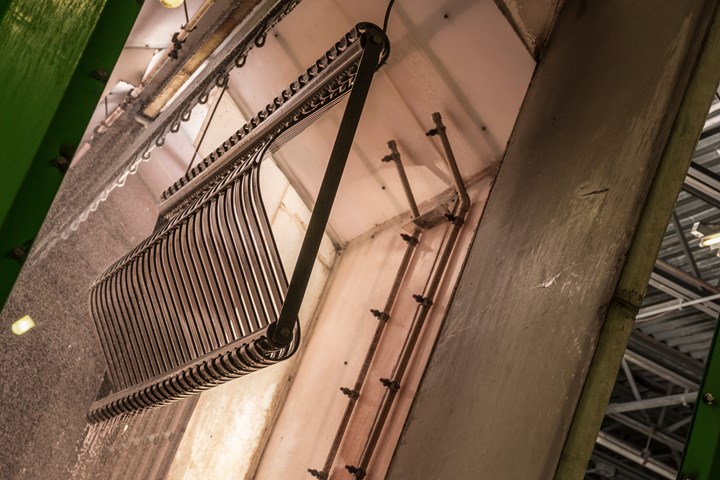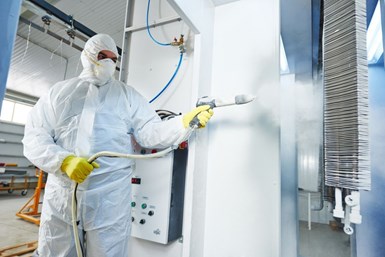
Product exiting Keystone Koating’s 8-stage pretreatment system.
Photo Credit: Keystone Koating
The architectural industry faces plenty of challenges when it comes to environmental concerns, and rightly so. While you can quickly find yourself debating the ins and outs of regulatory issues, at the end of the day we all care about the environment. We all want clean water to drink and clean air to breathe. Ultimately, guidelines, regulations and certification processes are crucial tools for making sure all of the proper steps are being taken to protect the environment.
In a recent blog post, Keystone Koating (Lititz, Pa.), an industrial powder coating contractor with over 30 years of experience, wrote about how powder coating is an excellent way for builders to work toward Leadership in Energy and Environmental Design (LEED) certification. Keystone Koating boasts that every stage of its process is designed to maintain compliance with all environmental regulations regarding atmospheric pollution.
Featured Content
Jonathan Nolt, quality assurance technician at Keystone Koating, points out that powder coating is one of the cleanest options available for coating architectural parts. Nolt oversees in-house testing, pretreatment systems and wastewater management for the company.
“One of the advantages with using powder coating for the architectural market is that powders have very little waste and very little to no VOCs,” Nolt says.

Powder coating offers environmental and sustainability benefits as it contains little to no VOCs, is often effective with a single coat, and overspray material can be collected and reused.
Powder coating technology is one mode of finishing that was built on eliminating waste from the get-go. One of powder coating’s greatest advantages is its environmental friendliness. The materials used for powder coating contain no solvents and little to no volatile organic compounds (VOCs). In addition, powder coatings are often effective with a single coat, meaning less material usage and less energy for the application and curing process.
The use of powder coating can also help eliminate waste because after application, powder coating overspray can be reclaimed and reused. Overspray for both powders used in powder coating, as well as abrasives used in blasting for surface preparation, can be collected and is perfectly suitable for reuse. These types of reclamation practices keep overhead costs low while minimizing environmental impacts.
Keystone Koating offers coatings to AAMA 2604 and AAMA 2605 specifications, which helps builders achieve environmental advantages. AAMA 2604 powder coatings are formulated with highly durable polyester resins, providing color and gloss retention for approximately five years of exposure. AAMA 2605 is the high-performance exterior specification, offering approximately 10 years of weathering, moisture and UV radiation resistance.
These advantages in durability, as well as the minimal impact that powder coating processes inflict on the environment, help the material meet standards set by the U.S. Green Building Council (USGBC) in the LEED business program.
LEED certification
Developed by the U.S. Green Building Council, LEED is the world’s most widely used green building certification program. The program is based on a points system that determines how environmentally sound a given building is. The certification takes into account such criteria as water efficiency, energy usage and CO2 emissions. Other criteria considered are the materials and processes used in the building’s construction. Basically, if your building receives enough points, it will earn a certification, and a higher score can lead toward higher levels of certification.
But how do builders go about getting LEED certification?
EPDs
The materials you use make a difference. An important factor in working toward an eco-friendly construction is keeping environmental product declarations (EPDs) in mind during the selection of materials that will be used for building. EPDs are internationally recognized documents that can be awarded to the materials and processes used to create a product. Materials that are created using clean resources and that limit detrimental environmental impacts can earn an EPD.
At the end of the day, when a building project uses more materials with EPDs, it’s more likely to qualify for LEED certification.
Green processes
Like many powder coaters, Keystone Koating says that because powder coating is free of VOCs and Hazardous Air Pollutants (HAPs), its process emits virtually no air pollution — even for high volume orders of significant quantities.
In addition, the company cites the use of green production methods including an 8-stage pretreatment system that relies on collected rainwater and eliminates wastewater discharge through evaporation methods.
“We have a cistern and collect rainwater from our roofs,” Nolt explains. “We run that through an RO [reverse osmosis] water filtration system and use it for our pretreatment system.”
Nolt adds that the wastewater is run through a clay flocculant to filter out any solids and is then sent to evaporators. Nolt says that more than 90% of the wastewater is evaporated using heat that comes from the exit end of the company’s cure ovens. The company’s Lititz and Mifflintown facilities both use energy-efficient infrared heating systems to expedite the curing process and reduce its carbon footprint. To maximize its overspray collection, the company uses systems and techniques designed for maximum reclamation of powder.
Partnering with builders
One of the attractive benefits of powder coating from its very inception has been its potential for reducing waste, both contributing to reduced material costs and sustainability gains. The durability and environmental advantages of the material make the coating an excellent choice for many architectural applications. Gaining an understanding of how such certifications like LEED are achieved can help powder coating operations better partner with architectural and construction firms to help them determine the right coatings for their building project.
You can learn more about the U.S. Green Building Council and LEED certification by visiting usgbc.org.
RELATED CONTENT
-
Coating Systems with the Best Long-Term Performance
The best protection against corrosion and UV exposure, says Axalta’s Mike Withers, is electrocoat and a super durable powder coating.
-
Understanding Infrared Curing
Infrared cure is gaining increased attention from coaters as a result of shorter cure cycles and the possibility of smaller floor space requirements when compared to convection oven curing.
-
Anodizing Vs. Powder Coat
I am an engineer on a large yacht build project and urgently need information and advice on choosing a finish for the aluminum deck plates in the engine room.




















